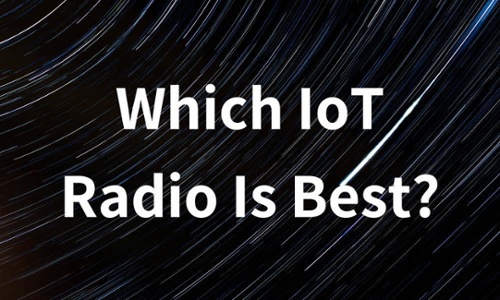
The world of IoT is rapidly developing and changing.
Since the industry itself is still in its infancy, there are many options for radios and varying standards for different IoT segments.
When choosing a radio for your IoT application there are a number of factors to consider.
These factors include: range, bandwidth, latency time, power consumption, frequency band, security, and cost.
Below is a table showing the characteristics of the major IoT radio technologies.

Each of these radios was designed to fill a specific niche and each has benefits and trade-offs.
Low energy BlueTooth (BLE) for example is an excellent choice for applications where energy harvesting is used since its power consumption is low and 90% of smartphones already have a BLE radio in them.
One major disadvantage of BLE is the range.
Though the range is higher than some of the other radio technologies like Z-Wave, ZigBee, Ant+, and WirelessHART; it is still too short for many remote sensor deployments.
If both low energy consumption and long-range capability are important LoRaWAN may be the best choice.
This technology pairs well with energy harvesting applications due to its low energy consumption, but trade-offs come in the form of increased data latency and interface infrastructure.
In a LoRaWAN system, there must be a main antenna gateway installed that can collect the data from the deployed devices and push it to the cloud or store it on a private network.
When an application calls for an increased installation location, flexibility and long-range capability, the solution may require a system that uses the existing cellular infrastructure.
There are currently a number of these systems either available in various parts of the world or coming online in the next few years.
These systems can be deployed in many places with no investment in gateway hardware, unlike LoRaWAN, they use cellular systems and will be subject to usage contracts with one or more cellular providers.
These systems have higher power consumption than LoRaWAN, but improvements in power consumption have been made.
The original 2G, 3G, and 4G radios had high power consumption, but the newer NB-IoT and LTE-M1 standards which are in their infancy and not yet universally available have much lower power consumption.
Power consumption is ultimately based on use case.
If low power consumption and long battery life are important for your sensor system, here are a few tips.
-
Consider technologies that are designed for low power consumption.
-
Pay careful attention to the design of the sensor system always keeping power consumption in mind.
-
Make all system components sleep as much as possible since this is the lowest energy consumption state.
-
Only transmit data when necessary since this is the highest energy consumption state for a radio. (One way to reduce transmissions and collect the same amount of information is to collect data at the desired interval and transmit multiple packets of information after a number of data acquisitions. This only works if the system does not need the sensor data with low latency).
-
Add an energy source to the system that can recharge batteries such as a solar panel. Solar panels can extend the battery life of a system nearly indefinitely (Learn more about PowerFilm’s Electronic Component Solar Panels).
Light is one of the most powerful and available sources of energy for IoT sensors. Solar cells are uniquely positioned to harvest the most energy for an IoT system whether indoors or outdoors.
Do you have IoT power needs or want help in determining which radio would be best for your application?
We would love to hear from you!
Contact us or leave a comment below.